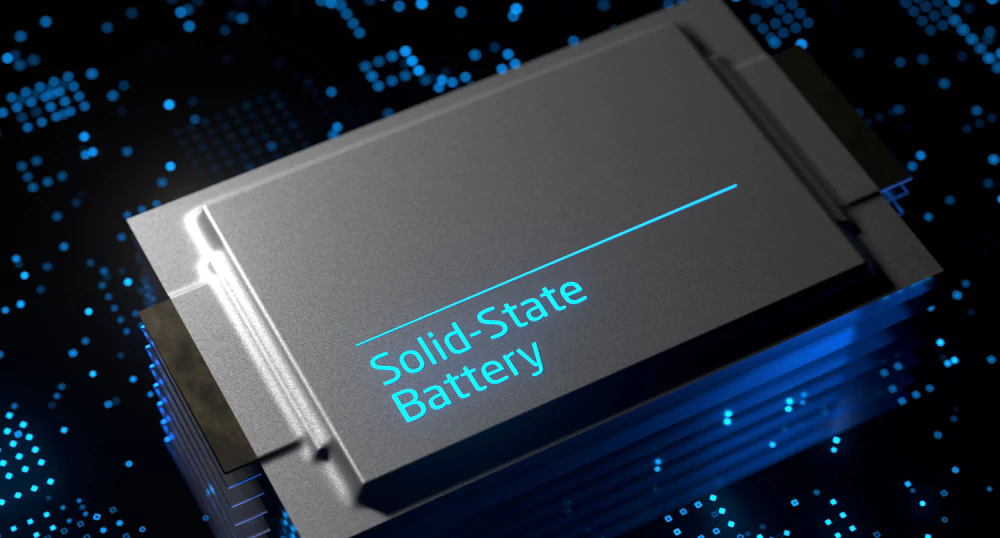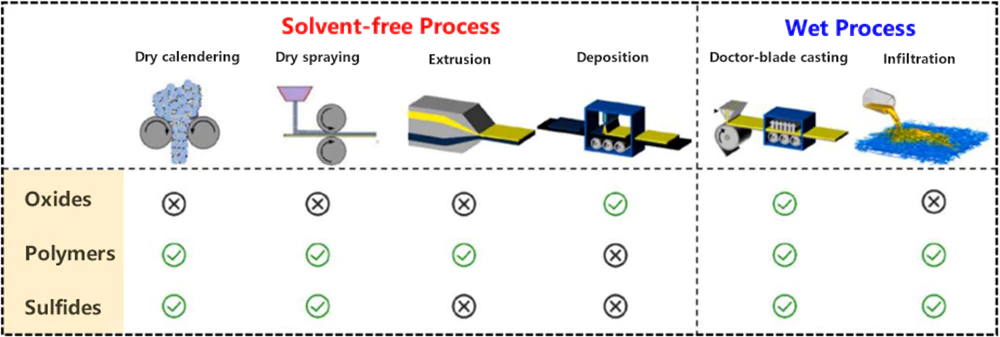Solid-state batteries and liquid batteries have many similarities in manufacturing processes. For example, the manufacturing process of electrode sheet is based on slurry mixing, coating and calendering. After slitting, the tabs are welded and PACK (battery packs are processed into groups). However, there are also some differences.
There are three core differences:
1) Composite cathode materials for solid-state batteries. A mixture of solid electrolyte and cathode active material is used as a composite cathode.
2) Different electrolyte addition methods. Liquid batteries filling electrolyte into the battery after the tabs are welded and packaged. In addition to forming a composite cathode with the cathode active material, solid electrolytes also need to be coated again on the rolled composite cathode.
3) Liquid lithium-ion battery electrode sheet can be combined by winding or stacking. Solid-state batteries are usually packaged in stacking form because their solid electrolytes such as oxides and sulfides have poor toughness.

The core technology of solid electrolyte is film formation, which can be divided into dry process, wet process and other processes.
The core technology of solid-state battery manufacturing is the solid electrolyte film formation process. The film formation process of electrolyte will affect the thickness and related properties of electrolyte. If the thickness is too thin, its mechanical properties will be relatively poor, which is easy to cause damage and internal short circuit. If the thickness is too thick, the internal resistance will increase. Since the electrolyte itself does not contain active substances, the energy density of battery cells and systems will be reduced.

Wet film forming process:
Mold-supported film forming, suitable for polymer and composite electrolytes, pour the solid electrolyte solution into the mold, and obtain the solid electrolyte film after the solvent evaporates.
Positive electrode support film formation is suitable for inorganic and composite electrolyte film. The solid electrolyte solution is directly poured on the positive electrode surface, and after the solvent evaporates, a solid electrolyte film is formed on the positive electrode surface.
The skeleton-supported film is suitable for composite electrolyte film. The electrolyte solution is injected into the skeleton, and after the solvent evaporates, a solid electrolyte film with skeleton support is formed, which can improve the mechanical strength of the electrolyte film.
The core of the wet process is the selection of adhesives and solvents. The solvents are easy to evaporate and have good solubility and chemical stability for electrolytes.
The disadvantages of the wet process are that the solvents may be toxic, the overall cost is relatively high, and if the solvent evaporates incompletely, the ionic conductivity of the electrolyte may be reduced.
Dry film forming process:
Mix the electrolyte and the binder, grind and disperse them, and pressurize (heat) the dispersed mixture to prepare a solid electrolyte film. This method does not use solvents and there is no solvent residue. The disadvantage of the dry method is that the electrolyte film is relatively thick, and since it does not contain active substances, it will reduce the energy density of the solid-state battery.
Other film-forming processes:
Including chemical, physical, electrochemical vapor deposition and other methods. Such processes are relatively expensive and are suitable for thin-film all-solid-state batteries.
There are many solid electrolyte film-forming methods. Polymers, sulfides and oxides can match the most suitable film-forming process based on their own characteristics.
(1) Polymer solid electrolytes have the best processing performance and the strongest process compatibility. Except for the fact that they cannot be granulated and are not suitable for the deposition method, polymer solid electrolyte film formation can be achieved by dry calendering, dry spraying, extrusion, tape casting and infiltration.
(2) Sulfide is not suitable for high temperature extrusion and small size deposition due to its poor air stability. Other processes such as rolling and spraying can be used for sulfide solid electrolyte film formation.
(3) Oxides have ceramic properties and are highly brittle, so they need to be formed into films by combining particle deposition and sintering, or by casting under solution blending conditions.
Semi-solid batteries are compatible with traditional lithium battery production processes, and production equipment is basically compatible with lithium batteries. It only requires the addition of a new production line dedicated to semi-solid separators, and the production equipment is compatible with the equipment for liquid battery separators.
Semi-solid batteries require the separators to have a larger pore size and higher strength and use a wet process plus coating process.
Compared with traditional batteries, there is no obvious process change in the separators of semi-solid batteries, and the parameters can be adjusted. However, because semi-solid batteries need to improve ion conductivity, the separators require a larger pore size and higher strength, so a wet stretching and coating process is required.
In addition, the demand for separators per unit for semi-solid battery has not changed.